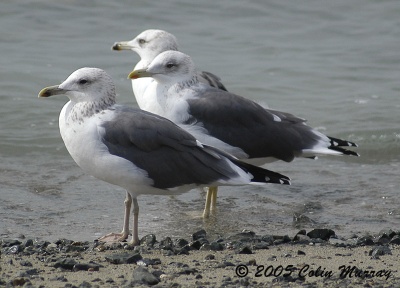Includes Heuglin's Gull
- Larus fuscus
Identification
Adult: The Lesser Black-backed Gull is a large white-headed gull which comes into contact with similar species across its range. Nominate L. f. fuscus or Baltic Gull is long-winged with a black mantle and yellow legs in adult plumage differentiating it from similar Herring Gulls (mantle colour, leg colour & wing-length) and Great Black-backed Gulls (leg colour & build).
L. f. intermedius is less elegant, having shorter, broader wings than nominate but longer than L. f. graelsii. L. f. graelsii, the subspecies of North-western Europe has a build closer to Herring Gull or Yellow-legged Gull rather than Baltic Gull. It is told from these by its slate grey back, darker than both.
Younger birds: Lesser Black-backed Gull takes four years to reach full adult plumage, starting with a dark and heavily patterned brown and gradually attaining adult characteristics.
Distribution
A common and widespread gull in the north of the region. Breeds in Iceland, the Faroes and British Isles, in Portugal and north-west Spain and from Brittany to Denmark, coastal Norway and Sweden, inland in Finland and north-west Russia and also on the coast of northern Russia.
Northern and eastern populations are migratory with winter range extending from Britain south to North-West Africa and throughout the Mediterranean.
Occurs on passage over much of Central and Western Europe.
Vagrant north to Svalbard and Bear Island and south to the Azores and Armenia.
Taxonomy
The Lesser Black-backed Gull is part of a gull clade called the large white-headed gulls. This includes Yellow-legged Gull, Herring Gull and several other species. The taxonomy of this group is currently being radically remodelled with many species being split. A taxon here included under Lesser Black-backed Gull may be candidate for full species in due course: L. heuglini.
Subspecies
Four subspecies are recognized[1]:
- L. f. fuscus: Dark-mantled
- L. f. intermedius:
- L. f. graellsii: Larger and paler-mantled
- Iceland, Faeroes, British Isles, France, Portugal; winters to western Africa
- L. f. heuglini:
- North-western Russia; winters to Middle East, South Africa and south-eastern Asia
Habitat
Quite catholic in its choice of habitats, perhaps less so than Herring Gulls, Lesser Black-backed Gulls are commonly found nesting on rooftops in coastal towns and cities as well as more traditional areas such as rocky islands and grass-covered tops of mainland cliffs.
In winter these birds can be found amongst mixed species gull flocks both on the coast and inland, often frequenting landfill sites. On passage these birds can occur anywhere.
Behaviour
Diet
Lesser Black-backed Gulls are opportunist feeders, eating anything they can digest and utilising transient food sources. They often use landfills for scavanging during the winter but they will take live prey given the opportunity. This includes molluscs, worms and crustaceans. Like other closely related species, Lesser Black-backed Gulls are omnivorous.
Vocalisation
<flashmp3>Larus fuscus (song).mp3</flashmp3>
Listen in an external program
References
- Clements, J. F., T. S. Schulenberg, M. J. Iliff, D. Roberson, T. A. Fredericks, B. L. Sullivan, and C. L. Wood. 2014. The eBird/Clements checklist of birds of the world: Version 6.9., with updates to August 2014. Downloaded from http://www.birds.cornell.edu/clementschecklist/download/
- BF Member observations
Recommended Citation
- BirdForum Opus contributors. (2024) Lesser Black-backed Gull. In: BirdForum, the forum for wild birds and birding. Retrieved 25 April 2024 from https://www.birdforum.net/opus/Lesser_Black-backed_Gull
External Links







